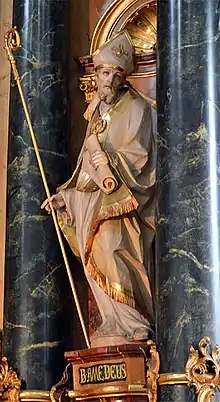Amadeus of Lausanne
Amadeus of Lausanne (c. 1110 – 27 August 1159) was a Cistercian monk, abbot of Hautecombe Abbey and the Catholic Bishop of Lausanne.

Life
Background, youth and education
Amadeus was born around 1110 in the castle of Chatte, west of Grenoble. His father was Count Amadeus the Elder of Clermont. After his mother's early death, he was sent to the Cistercian abbey of Bonnevaux at the early age of 10 to be educated there. His father entered the same monastery as a monk. In order to take advantage of even better educational opportunities, father and son moved to Cluny Abbey in 1121. The son soon moved on to the court of Emperor Henry V in order to learn life as a knight and prepare for an aristocratic career. Unsatisfied with this way of life, he chose to enter a Cistercian monastery in 1125, this time choosing the famous Clairvaux Abbey, then led by Saint Bernard of Clairvaux.
Abbot of Hautecombe
In 1139 he was sent to Hautecombe Abbey in Savoy to serve as its abbot; 200 monks came under his responsibility. One of his most momentous decisions was to move the community from its location to a new site on the shores of the Lac du Bourget. It was said that Amadeus' administrative skills, high ideals, piety, and education led Hautecombe to new heights as a religious community and of economic security.
Bishop of Lausanne
Pope Lucius II elevated Amadeus to the bishopric of Lausanne in 1144. The abbot was reluctant to accept, but was consecrated on January 21, 1145. His service as a bishop led to a period of spiritual and administrative stability for the region. He was often met with opposition, once having to flee the city because of violent residents. He was able to put the city under the protection of Berthold IV, Duke of Zähringen. Amadeus was particularly keen on educating the clergy better and leading them to deeper religious observance.
He was often in contact with the ecclesiastical and secular authorities of his day. Letters and charters attest to his contacts with King Conrad III, with Emperor Frederick I Barbarossa and the Cistercian Pope Eugene III, whom Amadeus knew from his days in Clairvaux. For a time, he served as the legal guardian for Blessed Humbert III, Count of Savoy, when Humbert's father Amadeus III died in the Second Crusade.[1]
Spirituality
As bishop, Amadeus often went on retreat at Haut-Crêt Abbey, located 15 km east of Lausanne. His Marian devotions are famous, but he also venerated St. Agnes a great deal because her memorial day (January 21) was the day Amadeus was born, began school, entered the novitiate, took his monastic vows, was made abbot, and consecrated a bishop.[2]
Death and subsequent veneration
Amadeus of Lausanne died in Lausanne in 1159, aged 49. He was interred in the cathedral before the Altar of the Holy Cross. Veneration was officially approved in 1710 by Pope Pope Clement XI and confirmed in 1903; official canonisation has not taken place. His feast day is August 27, the day of his death.
Marian Homilies
The eight Marian sermons are his most famous writings. As a result, he is often quoted as a classic proponent of Marian piety in the 12th century. The seventh homily is particularly relevant, since Pope Pius XII quoted from it in his Apostolic Constitution Munificentissimus Deus (1950) regarding the Assumption of Mary.[3]
References
- see Amadeus in German, French and Italian in the online Historical Dictionary of Switzerland.
- Théodore Koehler: The Heart of Mary in the Latin Tradition: From the Seventh to the Sixteenth Century. In: Marian Library Studies 25 (1996), p. 91-176, here 115–116.
- Eugene F. Rogers: After the Spirit: A Constructive Pneumatology from Resources Outside the West (Cambridge: William B. Eerdmans Pub, 2005), p. 109.
Bibliography
- Magnificat. Homilies in praise of the Blessed Virgin Mary. Cistercian Fathers Series, no. 18 (Kalamazoo, Mich.: Cistercian Publications, 1979)
- Andre Fracheboud: Cistercian Antecedents of the Rosary. In: Cistercian Studies Quarterly 33.2 (1998)
- Hilda C. Graef: Mary: a History of Doctrine and Devotion. (London: Sheed and Ward 1964)